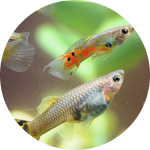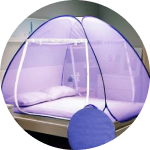Dengue
a silent killer
Dengue is a mosquito-borne viral infection. The virus is called Dengue virus and the mosquito that carries infection is female Aedes aegypti and albopictus.
Majority of Dengue disease cases present with flu like symptoms.Typically a person develops fever after 5-7 days of being bitten by an infective mosquito. In Dengue fever, the symptoms last 2-4 days and longer if severe disease.
Why is Dengue a Problem?
During COVID-19 pandemic, the vector borne disease outbreaks of Dengue are likely to worsen health outcomes if they co-exist due to compounded effect of haemorrhagic and cytokine response. This is of a bigger concern in endemic areas for Dengue, malaria, etc when the population faces two simultaneous outbreaks of COVID-19 and seasonal Dengue outbreak.
Why is Dengue a Problem?
Dengue and COVID-19
How does Dengue spread?
-
Dengue virus in India, is primarily spread by mosquitoes of species Aedes aegypti.
-
The Aedes mosquito is a day-biter. Only the female aedes mosquito bite as they need protein from hemoglobin for the development of eggs.
-
When a mosquito bites a dengue infected person, it gets infected and after 4-8 days of extrinsic incubation period, can spread dengue to any person it bites.
-
Aedes mosquito breeds almost entirely in man-made water receptacles found in and around households, construction sites and factories.
-
The mosquito larva grows in the stagnant water and in just over a week’s time becomes a fully developed adult mosquito.
Watchout for these symptoms
Illness caused by dengue virus is characterized by a high fever and at least two of the following

Treatment
- There is no specific treatment for dengue.
- Symptomatic treatment is given based on symptoms.
- No vaccines currently available for dengue
- It is self-limiting and mostly severe cases require hospitalization/blood platelet transfusion, and other supportive treatment.
- Supportive therapy and hospitalization might be required for more severe form with bleeding tendencies (Dengue haemorrhagic fever) and shock (Dengue shock syndrome).
Prevention
The best way to prevent infection is to avoid being bitten by mosquitoes during the daytime. Dengue is an avoidable nuisance which can be tackled effectively through the following simple measures
FAQ's
Frequently Asked Questions
Send in your questions to projectfever@drreddys.com
- Severe pain in the abdomen
- Persistent vomiting
- Bleeding in the skin (appearing as small red or purplish spots)
- Nose bleeds
- Bleeding from gums
- Passage of black stools like coal tar
Take the patient to a hospital whenever the first two signs – severe abdominal pain and persistent vomiting – are detected. Usually it is too late for effective treatment if we wait until bleeding has occurred. The most dangerous type of dengue is dengue shock syndrome (DSS). It is recognized by signs such as:
- Excessive thirst
- Pale and cold skin (due to very low blood pressure)
- Restlessness
- A feeling of weakness
Recent FAQ's
Can I get dengue fever from another person?
Dengue is not contagious. It does not spread directly from person-to-person through physical contact. It only spreads through the bite of an infected Aedes mosquito. When an infected person is bitten by a mosquito, the mosquito might later bite other people. Therefore, patients should be protected against contact with mosquitoes. This can be achieved by ensuring that people follow preventive measures (described below).
Can dengue fever be treated at home?
Most patients with dengue fever can be treated at home. They should take rest, drink plenty of fluids and maintain a nutritious diet. Whenever available, oral rehydration salts (commonly used in treating diarrhoea) should be taken. Sufficient fluid intake is very important, and becomes critical if the fever progresses into dengue haemorrhagic fever, where loss of body fluid/blood is the most salient feature. It is important to look out for danger signs and contact the doctor as soon as one or more of these are noticed.
Can I get dengue fever from another person?
Dengue is not contagious. It does not spread directly from person-to-person through physical contact. It only spreads through the bite of an infected Aedes mosquito. When an infected person is bitten by a mosquito, the mosquito might later bite other people. Therefore, patients should be protected against contact with mosquitoes. This can be achieved by ensuring that people follow preventive measures (described below).
Can dengue fever be treated at home?
Most patients with dengue fever can be treated at home. They should take rest, drink plenty of fluids and maintain a nutritious diet. Whenever available, oral rehydration salts (commonly used in treating diarrhoea) should be taken. Sufficient fluid intake is very important, and becomes critical if the fever progresses into dengue haemorrhagic fever, where loss of body fluid/blood is the most salient feature. It is important to look out for danger signs and contact the doctor as soon as one or more of these are noticed.
Can I get dengue fever from another person?
Dengue is not contagious. It does not spread directly from person-to-person through physical contact. It only spreads through the bite of an infected Aedes mosquito. When an infected person is bitten by a mosquito, the mosquito might later bite other people. Therefore, patients should be protected against contact with mosquitoes. This can be achieved by ensuring that people follow preventive measures (described below).
Can dengue fever be treated at home?
Most patients with dengue fever can be treated at home. They should take rest, drink plenty of fluids and maintain a nutritious diet. Whenever available, oral rehydration salts (commonly used in treating diarrhoea) should be taken. Sufficient fluid intake is very important, and becomes critical if the fever progresses into dengue haemorrhagic fever, where loss of body fluid/blood is the most salient feature. It is important to look out for danger signs and contact the doctor as soon as one or more of these are noticed.





















